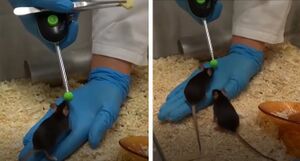Difference between revisions of "Clicker training"
m |
Werenskjold (talk | contribs) |
||
| Line 1: | Line 1: | ||
| − | Clicker training is an operant conditioning based on positive reinforcement. When the animal offers the desired behavior, a ''click'' or another distinctive sound (secondary reinforcer) is delivered and within the following few seconds the reward is presented (primary reinforcer)<ref name=":0">{{Cite journal|last=Feng|first=Lynna C.|last2=Howell|first2=Tiffani J.|last3=Bennett|first3=Pauleen C.|date=2016-08-01|title=How clicker training works: Comparing Reinforcing, Marking, and Bridging Hypotheses|url=http://www.sciencedirect.com/science/article/pii/S0168159116301393|journal=Applied Animal Behaviour Science|language=en|volume=181|pages=34–40|doi=10.1016/j.applanim.2016.05.012|issn=0168-1591|df=dmy-all}}</ref>. The ''click'' bridges the time between the desired behavior and the presentation of the reward<ref name=":0" />. A target stick providing a visual guide for the animal can be used for the training. | + | Clicker training is an operant conditioning based on positive reinforcement. When the animal offers the desired behavior, a ''click'' or another distinctive sound (secondary reinforcer) is delivered and within the following few seconds the reward is presented (primary reinforcer)<ref name=":0">{{Cite journal|last=Feng|first=Lynna C.|last2=Howell|first2=Tiffani J.|last3=Bennett|first3=Pauleen C.|date=2016-08-01|title=How clicker training works: Comparing Reinforcing, Marking, and Bridging Hypotheses|url=http://www.sciencedirect.com/science/article/pii/S0168159116301393|journal=Applied Animal Behaviour Science|language=en|volume=181|pages=34–40|doi=10.1016/j.applanim.2016.05.012|issn=0168-1591|df=dmy-all}}</ref>. The ''click'' bridges the time between the desired behavior and the presentation of the reward<ref name=":0" />. A target stick providing a visual guide for the animal can be used for the training. |
[[File:Clicker training in mice.jpg|thumb|'''Clicker training with mice using a target stick.''' ''Left:'' The mouse is following the target stick and is climbing on the experimenter's hand. If the hand is lifted, the mouse will remain on the palm of the hand. ''Right:'' The mice are trained in a group. Two mice are following the target stick on the palm of the experimenter's hand.]] | [[File:Clicker training in mice.jpg|thumb|'''Clicker training with mice using a target stick.''' ''Left:'' The mouse is following the target stick and is climbing on the experimenter's hand. If the hand is lifted, the mouse will remain on the palm of the hand. ''Right:'' The mice are trained in a group. Two mice are following the target stick on the palm of the experimenter's hand.]] | ||
Revision as of 22:14, 31 January 2021
Clicker training is an operant conditioning based on positive reinforcement. When the animal offers the desired behavior, a click or another distinctive sound (secondary reinforcer) is delivered and within the following few seconds the reward is presented (primary reinforcer)[1]. The click bridges the time between the desired behavior and the presentation of the reward[1]. A target stick providing a visual guide for the animal can be used for the training.

Animals are usually trained individually, though it is also possible to perform clicker training in a groups, e.g. in mice, rats, and rabbits. For rats, it was demonstrated that they learned tasks by observing the clicker traníning of their cage mates[2].
Clicker training can be used to train animals in a stress-free way. The following behaviours are examples for what this technique can be used for:
Mice: entering a tunnel, following a target stick, climbing on the palm of the hand[3]
Rats: following a target stick, voluntarily change to a cage, observational learning[2]
Rabbits: following a target stick, rearing/standing up to inspect the abdomen, approaching a human, being touched and lifted by a human, trimming nails, coming on command
Pigs: Pigs can be easily trained to cooperate if they are treated empathetically and desired behavior is reinforced by providing food stuff in form of treats and apple juice[4].
- ↑ 1.0 1.1 Feng, Lynna C.; Howell, Tiffani J.; Bennett, Pauleen C. (1 August 2016). "How clicker training works: Comparing Reinforcing, Marking, and Bridging Hypotheses". Applied Animal Behaviour Science. 181: 34–40. doi:10.1016/j.applanim.2016.05.012. ISSN 0168-1591.
- ↑ 2.0 2.1 Leidinger, Charlotte Sophie; Kaiser, Nadine; Baumgart, Nadine; Baumgart, Jan (25 October 2018). "Using Clicker Training and Social Observation to Teach Rats to Voluntarily Change Cages". JoVE (Journal of Visualized Experiments) (140): e58511. doi:10.3791/58511. ISSN 1940-087X. PMC 6235608. PMID 30417890.
- ↑ Leidinger, Charlotte; Herrmann, Felix; Thöne-Reineke, Christa; Baumgart, Nadine; Baumgart, Jan (6 March 2017). "Introducing Clicker Training as a Cognitive Enrichment for Laboratory Mice". JoVE (Journal of Visualized Experiments) (121): e55415. doi:10.3791/55415. ISSN 1940-087X. PMC 5408971. PMID 28287586.
- ↑ "Positive Reinforcement Training in Large Experimental Animals" (PDF).
Experts for clicker training in mice and rats: TARC, Mainz, Germany